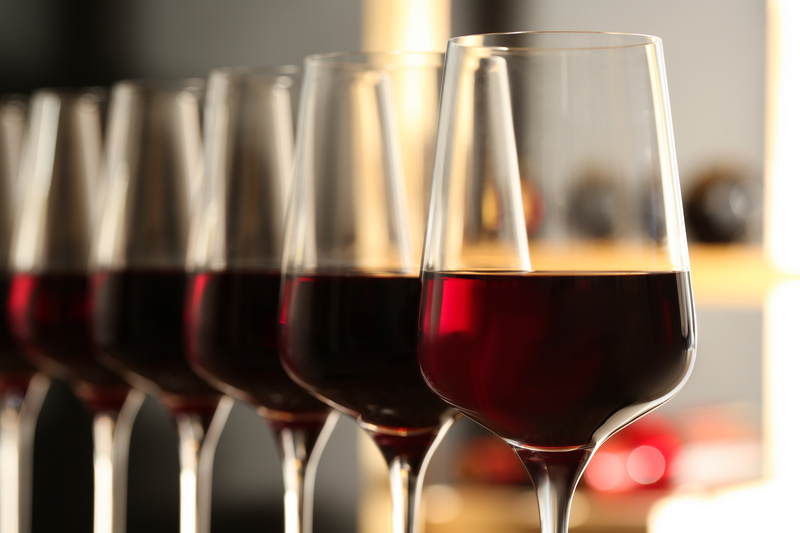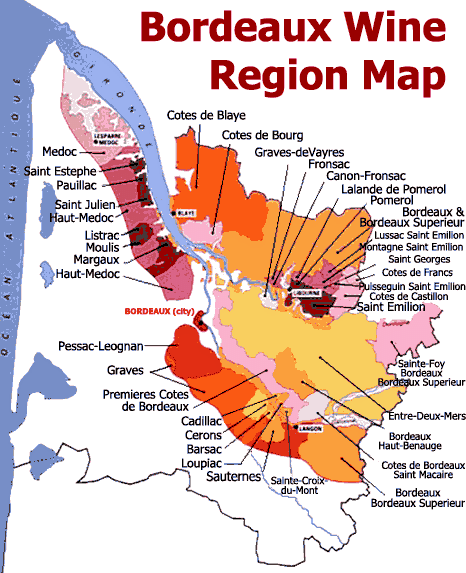BORDEAUX: THE BEDROCK OF WINE APPRECIATION
Did you ever wonder why Napa Valley winemakers blend Merlot and Cabernet Franc into their Cabernet Sauvignons? Why not Syrah to make them silkier, or Pinot Noir to make them lighter? Or Viognier to make them perfumier?
The reason is one of the fundamentals of wine: because that’s how red Bordeaux wines are made.
Back in 1976, a distinguished panel of French wine tasters couldn’t tell a California Cabernet from a red Bordeaux in the legendary Judgment of Paris tasting. After nearly 50 years of stylistic evolution, I doubt that anyone could mix them up today, with most Bordeaux wines riper than yesteryear, but still relatively restrained and drier than their New World counterparts.
But the fact remains that even the showiest of cult Napa Cabernets have their winemakers still gazing at Chateaus Latour, Mouton, Petrus et al for inspiration, or at least a template for their own choices of variety selections.

If you imagine wine in its own periodic table, red Bordeaux must be in the top row of elemental wines, along with the Chardonnays and Pinot Noirs of Burgundy, the Gamays of Beaujolais, the Chenin Blancs and the Sauvignon Blancs of the Loire Valley, Rieslings of Germany, Tempranillo of Rioja, Nebbiolo of Piedmont, Syrah of the Northern Rhone and the consequential blends Chateauneuf-du-Pape, Porto, and Champagne.
These are the bedrocks upon which all other wines come forth. Wine appreciation begins with these wines, because these wines have stood the test of time and continue to be the north star for the world’s winemakers and wine collectors.
If you claim to know about wine, you must learn about the wines of Bordeaux—red, white and sweet—because Bordeaux is foundational to wine understanding.
CLICK HERE FOR OUR CURRENT RED BORDEAUX SELECTION
CLICK HERE FOR OUR CURRENT WHITE BORDEAUX SELECTION
CLICK HERE FOR OUR CURRENT SAUTERNES SELECTION
That said, it doesn’t mean after a wine tasting or two on the subject, Bordeaux will suddenly become your favorite wine. The prices for the 62 classified growths alone can serve as a deterrent to enjoyment. Yet they remain stubbornly aspirational, even as we enjoy (and many times prefer) our sub-$30 Loire Cabernet Francs with our grilled steaks much more often. Do you know any red wine drinker who would turn down a glass of Chateau Margaux if it was offered? I don’t.
Because of the more recent success and influence of California wine in the past 40 years, wine education must spend time focusing on popular grape varieties, such as Chardonnay, Cabernet Sauvignon, Pinot Noir, Grenache, Sauvignon Blanc, Riesling, Chenin Blanc, Gewurztraminer, Viognier, Syrah. A wine student can learn a lot about these varieties in a classroom setting, immersing oneself in each varietal at a time, learning to appreciate the range of styles, the influence of warmer or cooler climates, soils, cooperage or stainless-steel vessels, and other winemaking choices. These are good exercises which help give definition to someone expanding their wine knowledge. The term “varietal character” seems to mean less these days, but it is still important to the individual desiring greater appreciation of what’s available in the marketplace. After an evening encountering a dozen well-chosen Nebbiolos from Alba, Barolo and Barbaresco with a good instructor, for example, you can get a lasting feel for the variety in one night.
Europeans, in general, identify their wines by the place they were grown rather than the variety of the grape. So why are the wines from Bordeaux so compelling even after the enormous success of Napa Valley Cabernet? One answer, of course, is a sense of timelessness. Chateau Haut Brion was raved about in the 1600s England by none other than Samuel Pepys, and sought out all over the world after the 1855 Classification (that’s 168 years ago if you’re counting). Even today, Bordeaux has an immense pull for the world’s wine collectors.
The Basics of Bordeaux
So what about it?
By a long shot, most of the wines of Bordeaux are red, some are white, a scant handful have the audacity to make rosé, and some of the world’s most prized sweet wines are also produced, usually in tiny quantities.
The traditional grape varieties allowed for red Bordeaux are Cabernet Sauvignon, Cabernet Franc, Merlot, Petit Verdot and Malbec. I'm intentionally not counting the legacy grape Carmenere which is still on the books, but more successfully taken root in Chile. Recent developments in climate warming have officials approving some experimental varieties, including the port wine grape Touriga Nacional, to be grown there, but it’s unlikely that the Classified Growths will adopt them in the foreseeable future. You may find “varietal” bottling in Bordeaux, but only in cheaper bottlings, practically never in prestige wines—tradition and vintage variation require they be blended.
For white wines (including Sauternes and Barsac), Semillon, Sauvignon Blanc, and a lesser-quality variety Muscadelle are permitted, the latter mostly used in lower-priced white wines.
Most red wines and the most prestigious whites use oak barrels for aging, both for development and for imparting flavor, although many less-expensive, fresher-tasting white wines are released after spending time in stainless-steel tanks only.
The Bordeaux wine region is named after its port city in southwestern France, and it is this fact that historically made Bordeaux wines successful in trading. For us wine enthusiasts, the Bordeaux wine region is primarily divided into the vineyards of the “Left Bank” (west of the Gironde estuary and Garonne River) and vineyards of the “Right Bank” (east of the Dordogne River). A lot of wine, but very little prestige wine, is produced between the Garonne and the Dordogne, some Bordeaux Superieur and oceans of Entre-Deux-Mers, which make pleasant, undemanding dry white wines.

Earlier ripening grapes like Merlot dominate the Right Bank, while Cabernet Sauvignon is king of the Left Bank.
The principal communes of the Left Bank are Pauillac, Margaux, Saint-Estephe, Saint-Julien (all in the Medoc) and Pessac-Leognan/Graves south of the city of Bordeaux. The two towers of the Right Bank are Saint-Emilion and tiny, prized Pomerol, which has gained awesome prestige only in the past 50 or 60 years.
Bargains can be found in satellite regions of the Right Bank, like Blaye, Cotes de Bourg, Fronsac, Lalande-de-Pomerol, Castillon Cotes de Bordeaux and others. Lesser-priced, but good quality reds of the Left Bank can be found in Moulis, Listrac, Medoc and the Haut-Medoc, as well as bottles labeled Bordeaux-Superieur and Bordeaux.
What’s the Difference?
So, why are some red Bordeaux $15 and some $1,500? Is there really that much difference in taste, given they are grown in similar areas with the same blend of grape varieties?
Yes, there is a difference, but not 100 times the difference. The better chateaux were recognized a long time ago for the superior wines that came from specific vineyards with privileged soils and exposure. Because they have been sought after, their prices are higher, which allows their owners to invest in modern equipment, new barrels, and especially ideal vineyard management. And the most celebrated estates carry the most stratospheric prices. The rich get richer.
And that isn't only true of red wines from Bordeaux. Prestige white Bordeaux, mostly in Pessac-Leognan, use oak barrels and the most sought-after also carry stiff prices that reflect their relative rarity.
Are prestige wines better at the table? Well, that’s a subject we can debate all week long. The short answer is “it depends,” which I know satisfies no one. Food pairing is an art, not an absolute, and it is as individual as the person doing it. Young red Bordeaux wines are usually harder to consume with food due to their bitter tannins, which historically have resolved with time, but climate conditions are continuing to change prompting re-evaluations in this area. The modern fact that Bordeaux wines have been creeping up in alcohol since the 1970s, push some wines out of the traditional “table wine” purview (over 14%), but given most Americans drink wine with little or no food, this may be irrelevant to their enjoyment.
In the era of recent climate warming, old aging parameters are out the window. In short, nobody knows is aging will make your cellar treasures more beautiful and elegant with time. It’s a whole new world.
Even with that said, there is a special pull to the wines of Bordeaux--perhaps the trappings of wealth, the venerable history, the association with British nobility or the desire for a Cabernet-ish Old World red to drink with a simple slab of roast beef--that continues to charm wine lovers throughout the globe.
If you are attending a sit-down tasting like the ones we periodically host at The Wine Country, you will be able to compare for yourself the difference between serviceable, quite good wines and aspirational ones. Then you’ll be able to decide whether the extra money for the history, quality and depth of classified growths is worth it. You may be surprised.












